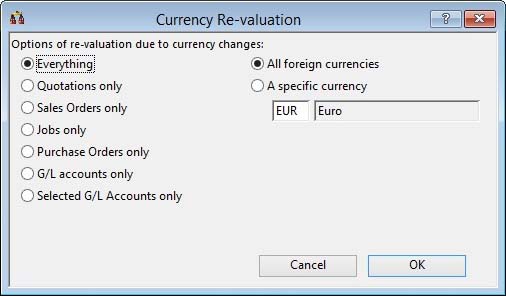Currency Re-valuation
When a currency exchange rate is changed, all subsequent new transactions involving the currency will use the new exchange rate. However, any existing Jobs, Purchase or Sales Orders and G/L Accounts will be valued, in terms of local currency, using the exchange rates that applied at the time they were created or last re-valued at. If you want the local currency conversions to apply at the new exchange rate, you must re-value using the Re-value System button on the Currency Control window.
You have a choice of re-valuing all uses of currencies or just a specific use (G/L Accounts only is only an option if you have entered the Currency maintenance window from the G/L menu.) Re-valuation can be applied to all foreign currencies or just a specific currency. If you choose only a specific currency, you must enter the currency code in the field and tab to confirm. Only those documents or accounts of that currency will then be re-valued. Re-valuation can take some time.
|
Field |
Description |
|---|---|
|
iCurName |
Currency Rates. Currency name. {CURFILE.CURNAME char 20} |
|
iCurrency |
Currency Rates. Currency symbol code. {CURFILE.CURCODE char 3} |
|
A specific currency |
Re-values the selection options for the specific foreign currency entered below. |
|
All foreign currencies |
Re-values the selection options for all foreign currencies. |
|
Everything |
Re-values currency Quotations, SOs and Jobs with no invoicing, POs with no receipts and G/L bank accounts. |
|
Quotations only |
Re-values only currency Quotations. Quotations have no inherent value conversion that effect other data files until they are confirmed to Sales Orders. However, in Sales Order reports currency quotations are normalised to local currency. When a Quotation is confirmed to a Sales Order, the SO will be given the exchange rate applicable to the Quotation and therefore should be re-valued to reflect current rates. |
|
Sales Orders only |
Re-values only currency Sales Orders that have no dispatches. The normalised value of Sales Orders contributes to the value stored in the On-order Value field of the customer record. The normalised value reflects the exchange rate applicable at the time the SO was created or last re-valued. Revaluation will cause the customer on-order values to be adjusted. |
|
Jobs only |
Re-values only currency Jobs that have no invoices. The normalised value of Jobs contributes to the value stored in the On-order Value field of the customer record. The normalised value reflects the exchange rate applicable at the time the Job was created or last re-valued. Revaluation will cause the customer on-order values to be adjusted. |
|
Purchase Orders only |
Re-values only currency POs that have no receipts. The normalised value of Purchase Orders contributes to the value stored in the On-order Value field of the supplier record. The normalised value reflects the exchange rate applicable at the time the Purchase Orders was created or last re-valued. Revaluation will cause the supplier on-order values to be adjusted. |
|
G/L accounts only |
Re-values G/L foreign currency accounts. Balance, turnover and budget values in General Ledger currency accounts are all stored in their respective currencies. When, however, these values are shown in lists or Profit and Loss or Balance Sheet reports the values are normalised into local currency at the exchange rate the accounts were last re-valued at. When revaluation takes place the overall ledger trading turnover and/or balance will be affected. The net change is applied to the Currency Trading Account in a single transaction. This ensures that the General Ledger remains in balance. The single transaction is given a document reference of “C-RVYYMMDD” (where YY is the year, MM the month and DD the day). The contra account will be shown as “CUR-REV”. |
|
Selected G/L Accounts only |
Re-values selected G/L foreign currency accounts. Operates in the same way as G/L Accounts but applies to only the selected accounts in the list. |
|
Account list |
List of foreign currency G/L Accounts. Select those you want to re-value. |
|
Button |
Action |
|---|---|
|
Cancel |
Aborts the process currently in session. The keyboard equivalent is the Esc key for Windows computers and Command-.(full stop or period) for the Mac. |
|
OK |
The OK button updates the data you have entered, or confirms the selection and/or processes the function you have called. |
| See also: – |
Compiled in Program Version 5.10. Help data last modified 7 May 2012 03:15:00.00. Class wAcCurRev last modified 23 Sep 2017 10:50:44.


